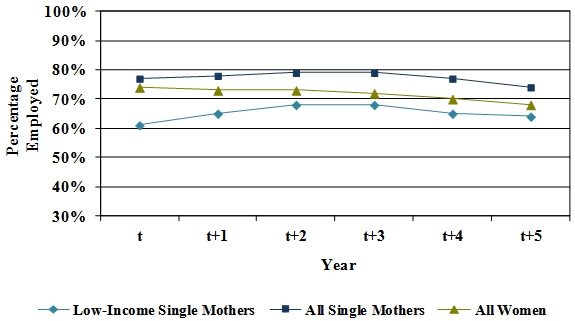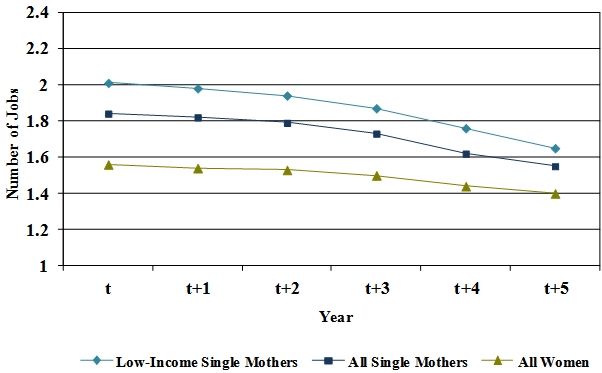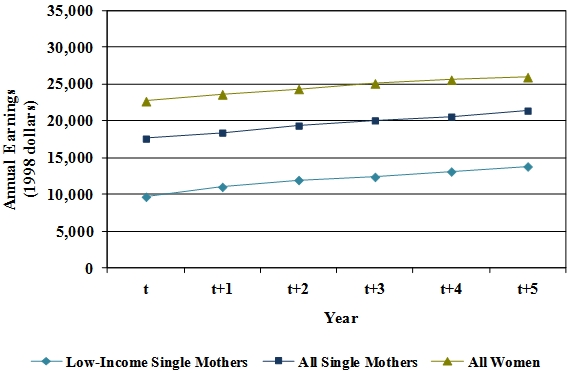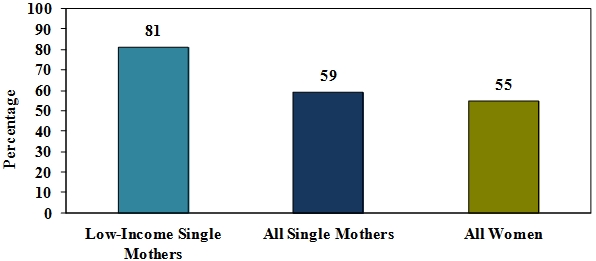This ASPE Research Brief, written by Susan Hauan of ASPE and Fredrik Andersson of the Department of Treasury, presents research findings on the relationship between the past work experiences of single mothers and their subsequent employment and earnings outcomes. The brief is based on a broader set of results that may be accessed at: http://aspe.hhs.gov/hsp/12/WorkHistories/index.shtml
Overview
This brief summarizes a study of the past labor market experiences of single mothers in the early- to mid-1990s and their subsequent employment outcomes over five years into the early 2000s. In contrast to the broader population, single mothers as a group had persistently lower rates of employment and lower earnings levels. Over time, their position in the labor market improved, with low-income single mothers in particular experiencing relatively rapid earnings growth and increased employment stability. Still, relatively large fractions of low-income single mothers continued to experience difficulties in the labor market, such as periods with no work and very low earnings when employed. It is this subset of lower-income single mothers that may be facing even greater employment and economic challenges given the current economic downturn.
Background
Single mothers entered the work force in record numbers during the 1990s (Lerman 2005), opening up greater possibilities for attaining economic self-sufficiency for themselves and their families. Most, however, earned low wages and previous research suggests that average wages decreased further for successive cohorts of low-income single mothers over this same time period (Primus 1999). The current study builds on this previous cross-sectional research by using a unique longitudinal dataset that follows the same women over time to examine the extent to which employment and earnings among individual single mothers increased or decreased during the 1990s and into the 2000s.
Data and Study Sample
For this study we pool data from the 1997 and 1998 Current Population Survey (CPS) Annual Social and Economic Supplement (ASEC) and link it to longitudinal earnings and employment information from 1991 to 2002 drawn from the Social Security Administration’s (SSA) Detailed Earnings Records (DER). The resulting integrated dataset yields the capacity to track the employment and earnings progression of individual single mothers over a total period spanning more than 10 years.[1]
The main study sample is comprised of single mothers ages 16 to 64[2] and we conduct much of our analysis on the subset of single mothers who were low-income in either 1996 or 1997 (depending on the year in which they were a respondent for the CPS). We refer to 1996 or 1997 as the “base year” for the study and examine employment and earnings experiences over the subsequent five-year outcome period ending in either 2001 or 2002. Also, our analyses include “historical” employment and earnings information for the six-year period prior to the base year for all sample members. The samples we analyze in the study are as follows:
- Single Mothers: Divorced, separated, never-married, or widowed women residing with at least one of their own children under the age of 18 at the time of the survey and women who head a female-headed household that contains a related child under 18 when the mother of that child is not present in the household at the time of the survey (7,279 in sample)
- Low-Income Single Mothers: Single mothers in the two bottom income quintiles of the sample at the time of the survey[3] (2,998 in sample)
- All Women: All women ages 16 to 64 at the time of the survey[4] (48,629 in sample)
The Characteristics of Single Mothers
Exhibit 1 displays select demographic characteristics for low-income single mothers, all single mothers, and the broader group of all women during the base year of the study. Single mothers tended to be younger, were more likely to be black, and had lower levels of educational attainment relative to all women. Single mothers, especially low-income single mothers, also were more likely to be poor and less likely to be covered by health insurance than women overall, and low-income single mothers were more likely than other women to report health or disability problems. Single mothers on average had a somewhat higher rate of employment than all women in the base year, but the subset of single mothers who were low-income had a much lower employment rate than the other two groups. Employed single mothers on average had lower earnings in the base year[5] than all women ($17,592 compared to $22,676). This was especially pronounced among working single mothers with low incomes who had average earnings of $9,673 during the base year of the study.
| Characteristic | Low-Income Single Mothers |
All Single Mothers | All Women |
|---|---|---|---|
| Age | |||
| 16-24 | 21% | 20% | 9% |
| 25-34 | 36% | 31% | 25% |
| 35-44 | 30% | 33% | 28% |
| 45-64 | 13% | 17% | 38% |
| Race | |||
| White | 65% | 71% | 85% |
| Black | 30% | 24% | 10% |
| Other | 5% | 5% | 5% |
| Education | |||
| Less than HS Graduate | 39% | 24% | 15% |
| HS Graduate | 58% | 65% | 61% |
| Bachelor's Degree | 3% | 10% | 23% |
| Postgraduate Degree | 0% | 0% | 1% |
| Poverty | |||
| Income Below Poverty Level | 88% | 38% | 14% |
| Health | |||
| Health or Disability Problem | 14% | 9% | 9% |
| No Health Insurance (self) | 29% | 25% | 17% |
| Labor Market | |||
| Employment | 61% | 77% | 74% |
| Earnings (1998 dollars) | $9,673 | $17,592 | $22,676 |
| Number in Sample | 2,998 | 7,279 | 48,629 |
| Source: Calculations for age, race, education, poverty, and health characteristics are based on the 1997 and 1998 Annual Social and Economic Supplement of the Current Population Survey. Calculations for employment and earnings are based on the Social Security Administration's Detailed Earnings Records. |
|||
Past Employment and Earnings Histories
The longitudinal data for this study permit the analysis of past employment and earnings histories. During the six years prior to the base year, single mothers consistently had less past employment experience, lower earnings when working, and held more jobs in each year relative to the broader group of all women. These disparities were especially evident when comparing the work histories of low-income single mothers and all women (results shown in full report, which can be accessed at: http://aspe.hhs.gov/hsp/12/WorkHistories/index.shtml).
Employment and Earnings Outcomes for Single Mothers
As discussed above, single mothers, especially low-income single mothers, often have lower levels of attachment to the labor market and lower earnings from the jobs they are able to secure relative to other women. But, do they experience improvements over time? What are the employment and earnings experiences of single mothers over a five-year period?
Employment. Single mothers experienced some gains in employment over time, but this progress slowed in the final years of the outcome period. As shown in Exhibit 2, the proportion of single mothers employed in a given year increased for the first several years of the outcome period from 77% in the base year to 79% three years later. The proportion employed then declined in the last two years of the outcome period to 74% when the economy was slowing in the early 2000s. For low-income single mothers, the proportion employed at the end of the period (64%) was still higher than the proportion employed during the base year (61%). But, for all single mothers together, any early improvements in employment were erased by the end of the five-year outcome period; decreases in employment during the later years of the outcome period brought the proportion of all single mothers employed to a level below their initial employment rate in the base year (74% compared to 77%).
Exhibit 2-Line chart of percentage of low-income single mothers, all single mothers and all women employed over five years. Employment levels for low-income single mothers rose during the first two years and then dropped somewhat during the last two years of the study outcome period. Employment was higher but the trend was fairly stable for all single mothers and all women over the five year period.
Source: Income and family characteristics are based on the 1997 and 1998 Annual
Social and Economic Supplement of the Current Population Survey. Employment
outcomes are based on the Social Security Administration's Detailed Earnings Records.
While single mothers’ employment gains eroded by the end of the study period, working single mothers experienced increased employment stability over the subsequent five years after we drew our sample. When single mothers were working, their employment volatility decreased as measured by a decline in the average number of jobs they held in each year over the course of the outcome period. As shown in Exhibit 3, working single mothers had an average of 1.84 jobs during the base year of our study, which decreased to an average of 1.55 jobs five years later. For employed single mothers with low incomes, the average number of jobs in a year decreased from 2.01 to 1.65 over the same time period.
Exhibit 3
Employment Volatility Among Workers
Exhibit 3-Line chart of number of jobs held among employed low-income single mothers, all single mothers and all women over five years. Low-income single mother workers were most likely and all working women were less likely to hold multiple jobs in a given year. The number of jobs held in a year decreased among all groups over the five year study outcome period.
Source: Income and family characteristics are based on the 1997 and 1998 Annual
Social and Economic Supplement of the Current Population Survey. Employment
outcomes are based on the Social Security Administration's Detailed Earnings Records.
Earnings. Single mothers experienced earnings growth over the course of the five-year outcome period. Indeed, all groups of women in our study experienced increases in earnings on average; but single mothers, and low-income single mothers in particular, experienced even greater percentage increases in their average earnings over time. Exhibit 4 shows that earnings[6] among employed single mothers increased in the five years following the base year from $17,592 to $21,384, a growth rate of 22% compared to a growth rate of 14% among all women. Among low-income working single mothers, earnings increased from $9,673 to $13,794 (a growth rate of 43%).[7]
Still, even with earnings increases, single mothers were not able to close the earnings gap between themselves and the more broadly defined group of all women in our study, and low-income single mothers lagged even further behind. As shown in Exhibit 4, single mothers, especially those at low-incomes, started at a much lower earnings level initially than all working women and earned consistently less than all women in each year of the outcome period.
Exhibit 4
Earnings Outcomes Among Workers
Exhibit 4-Line chart of annual average earnings among employed low-income single mothers, all single mothers and all women over five years. Low-income single mother workers had lower average earnings and all working women had higher average earnings in a given year. Average earnings levels increased among all groups over the five year study outcome period.
Source: Income and family characteristics are based on the 1997 and 1998 Annual
Social and Economic Supplement of the Current Population Survey. Employment
outcomes are based on the Social Security Administration's Detailed Earnings Records.
Persistence of Joblessness and Low Earnings
Despite some improvement in employment and earnings among single mothers on average over the five-year outcome period, a substantial proportion of single mothers and low-income single mothers remained out of the labor market or at the bottom of the overall earnings distribution.[8] As shown in Exhibit 5, 59% of single mothers and 81% of low-income single mothers were either not employed or were employed with earnings in the bottom two earnings quintiles in all years of the five-year outcome period, compared to 55% of all women.
Exhibit 5
Proportion not Employed or in Bottom Two Earnings Quintiles All Years in Outcome Period
Exhibit 5-Bar chart of percentage of low-income single mothers, all single mothers and all women either not employed or employed with earnings in the bottom two earnings quintiles in all five years of the study outcome period. A larger percentage of low-income single mothers and a smaller percentage of both all single mothers and all women spent all five years of the study outcome period without a job or working but with earnings in the bottom two earnings quintiles.
Source: Income and family characteristics are based on the 1997 and 1998 Annual
Social and Economic Supplement of the Current Population Survey. Employment
outcomes are based on the Social Security Administration's Detailed Earnings Records.
What Helps Single Mothers Get a Job and Earn More?
The previous results show substantial average differences in employment and earnings between single mothers, especially low-income single mothers, and all women. But, for those single mothers who gain employment and advance in the labor market, what helps the most? In this section we highlight the key factors that are most strongly correlated with labor market success among single mothers.
We estimate two sets of multivariate probit equations to examine labor market dynamics for low-income single mothers and all single mothers over time.[9] For the first set, we estimate the probability of working in at least one year during the outcome period among those not employed in the base year; second, we estimate the probability of earnings progression[10] between the base year and the outcome period. Each set includes a series of equations or models that take various combinations of past employment and earnings history measures into account. The main findings are summarized broadly below. A complete set of results is shown in the full report (which can be accessed at: http://aspe.hhs.gov/hsp/12/WorkHistories/index.shtml).
Employment. For those not employed in the base year, basic demographic characteristics were important factors in the likelihood of getting a job in the outcome period. Younger single mothers, including those with low incomes, were more likely to get a job and those who reported a health problem or disability were less likely. Single mothers with higher levels of education tended to have a greater likelihood of securing employment, although this relationship was more consistent among single mothers as a whole, than among those with low incomes. In some cases white single mothers were more likely to get a job than black single mothers, though these results depend on which other characteristics and experiences are taken into account.
Prior labor force patterns also matter in the transition to employment. Greater past labor force attachment, especially for low-income single mothers, was associated with a greater likelihood of getting a job among those not working in the base year. Even past employment experience in only one or two years significantly increased the likelihood of gaining employment, although past employment of three to four years and five or more years increased the likelihood of employment even more. Contrary to our expectations, past employment volatility (a history of frequent job changes) did not negatively affect the likelihood of getting a job. In fact, for all single mothers and low-income single mothers, we found that greater job volatility in the past improved the chances of gaining employment in later years.
Earnings. What factors help single mothers move up in the earnings distribution? For low-income and all single mothers with no or very low earnings in the base year, both basic demographic characteristics and employment histories were related to earnings progression. The patterns, however, differ somewhat from the employment analysis results discussed above.
Again, among low-income and all single mothers, those at younger ages tended to do better, but age appears to be less important in earnings progression than in getting a job. Further, unlike the previous results the race of single mothers was not significantly related to upward earnings mobility, taking other characteristics into account. Education appears to be even more important in earnings progression than in securing employment for single mothers as a whole as well as those with low incomes; more highly educated single mothers had a much greater likelihood of getting better paying jobs in the outcome period compared to those with less educational attainment. Similar to the employment analysis, single mothers who reported a health problem or disability were significantly less likely to advance in the earnings distribution but the relationship appears to be weaker relative to the employment results.
Again, prior employment histories are related to upward earnings mobility among low income and all single mothers. More years of past employment experience was associated with moving up in the earnings distribution, especially past employment of five years or more. Similar to the results for getting a job as discussed above, past employment volatility (or frequent job changes) also was related to an increased likelihood of getting a better paying job, especially for those who changed jobs two or more times.
Summary and Conclusion
As a group, single mothers are disadvantaged in the labor market along several dimensions. In our study, they had lower levels of educational attainment, a higher likelihood of reporting a health or disability problem, a higher incidence of poverty, and were less likely to be covered by health insurance than all women. These discrepancies were even more pronounced between low-income single mothers and the broader population of women. In addition, single mothers had fewer years of past employment experience, lower earnings when working, and much higher past job volatility than all women. In particular, low-income single mothers experienced high job turnover and substantial levels of joblessness throughout the historical period for this study.
Despite these difficulties, the position of single mothers as a group improved markedly. Low-income and all single mothers experienced early employment gains during the five-year outcome period, with past work experience in as few as one or two years and frequent job changes both helping those without jobs to secure employment. Single mothers experienced substantial earnings gains in subsequent years as well. In particular, higher educational attainment, longer work histories, and frequent job changes were important correlates of this earnings progression for low-income and all single mothers over time.
Still, over the course of the five-year outcome period, single mothers were not able to close the earnings gap between themselves and all women, and a substantial proportion of low-income and all single mothers remained out of the labor market or at the bottom of the overall earnings distribution. These single mothers are likely continuing to face labor market difficulties given the current economic downturn.
Sources Cited
Lerman, Robert, “How Did the 2001 Recession Affect Single Mothers?” Single Parents’ Earnings Monitor, The Urban Institute, 2005.
Primus, Wendell, Lynette Rawlings, Kathy Larin, and Kathryn Porter, “The Initial Impacts of Welfare Reform on the Incomes of Single-Mother Families,” Center on Budget and Policy Priorities, 1999.
Endnotes
[1] Longitudinal data on changes in marital status are not available, thus we are not able to distinguish single mothers who remain single from single mothers who marry at some point during the five-year outcome period. We were able to conduct a supplementary analysis on marital status changes between the base year (1996 or 1997) and 2000 using data from the 2000 Decennial Census and found that those single mothers who married had lower employment intensities and earnings compared to those who remained single.
[2] Single mothers enrolled in school at the time of the survey are excluded from the sample.
[3] Income quintiles are based on the Census Bureau’s official poverty thresholds. This approach adjusts income for family size, and has the effect that a larger family with a certain family income would be ranked as being more disadvantaged than a smaller family with the same income.
[4] Women enrolled in school at the time of the survey are excluded from the sample.
[5] For comparison purposes, all earnings estimates are adjusted to 1998 dollars.
[6] For comparison purposes, all earnings estimates are adjusted to 1998 dollars.
[7] Low-income single mothers cannot have very large earnings in the base year, since this would result in family incomes above the lowest two earnings quintiles. At the same time there are no such implicit restrictions on earnings before or after the base year. Thus, the earnings pattern of this group can partly be due to a “regression-to-the-mean” effect.
[8] Earnings quintiles are defined by year based on earnings among all workers including men and women, not just among the women in our sample. Those not employed or earning less than $1,000 a year are excluded from the calculation.
[9] All models control for age, race, educational attainment, and disability or health problems.
[10] Earnings progression is measured as a transition from no employment or employment with annual earnings in the bottom two earnings quintiles in the base year to annual earnings in the upper three earnings quintiles in all years of the outcome period. All earnings estimates are adjusted to 1998 dollars.




